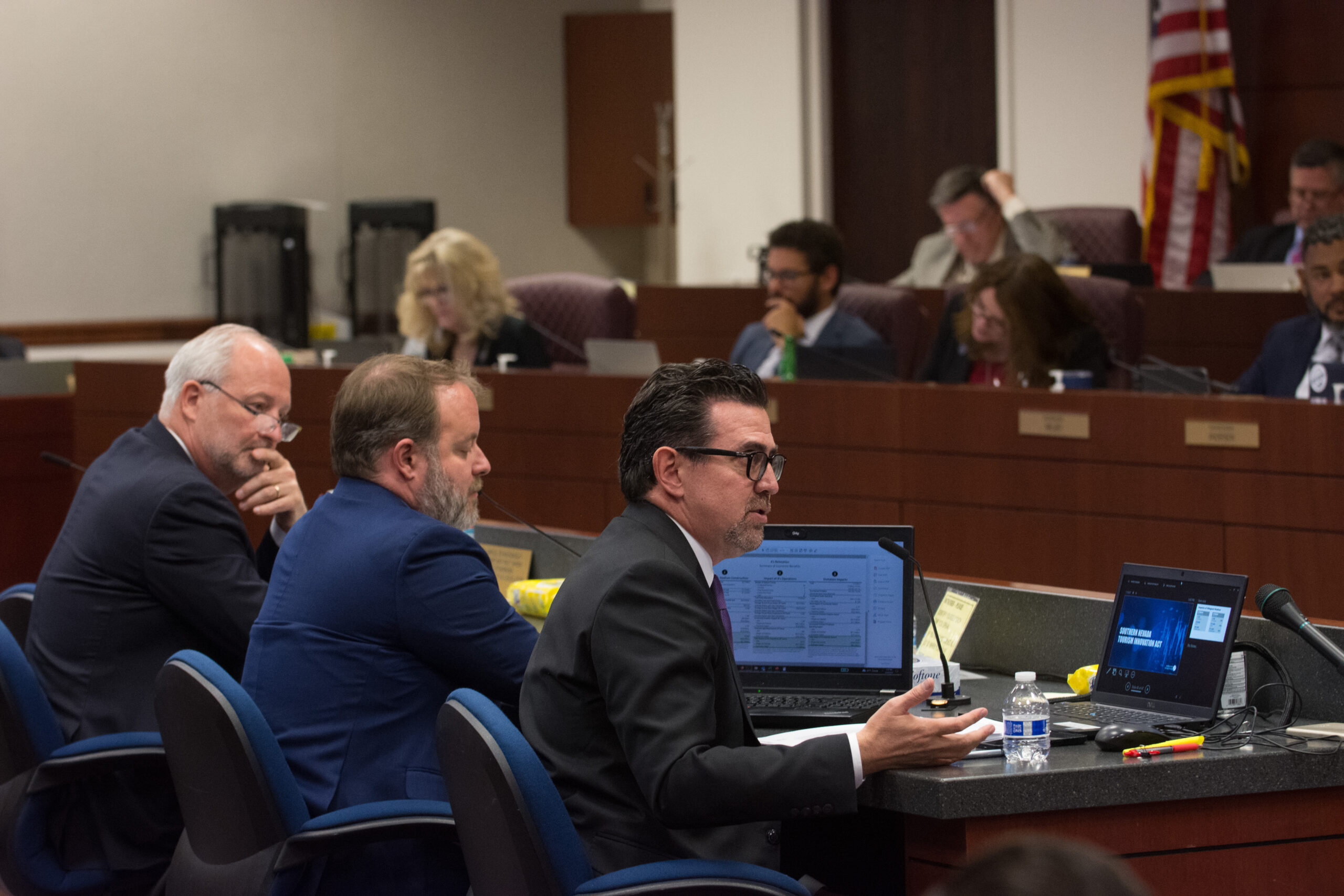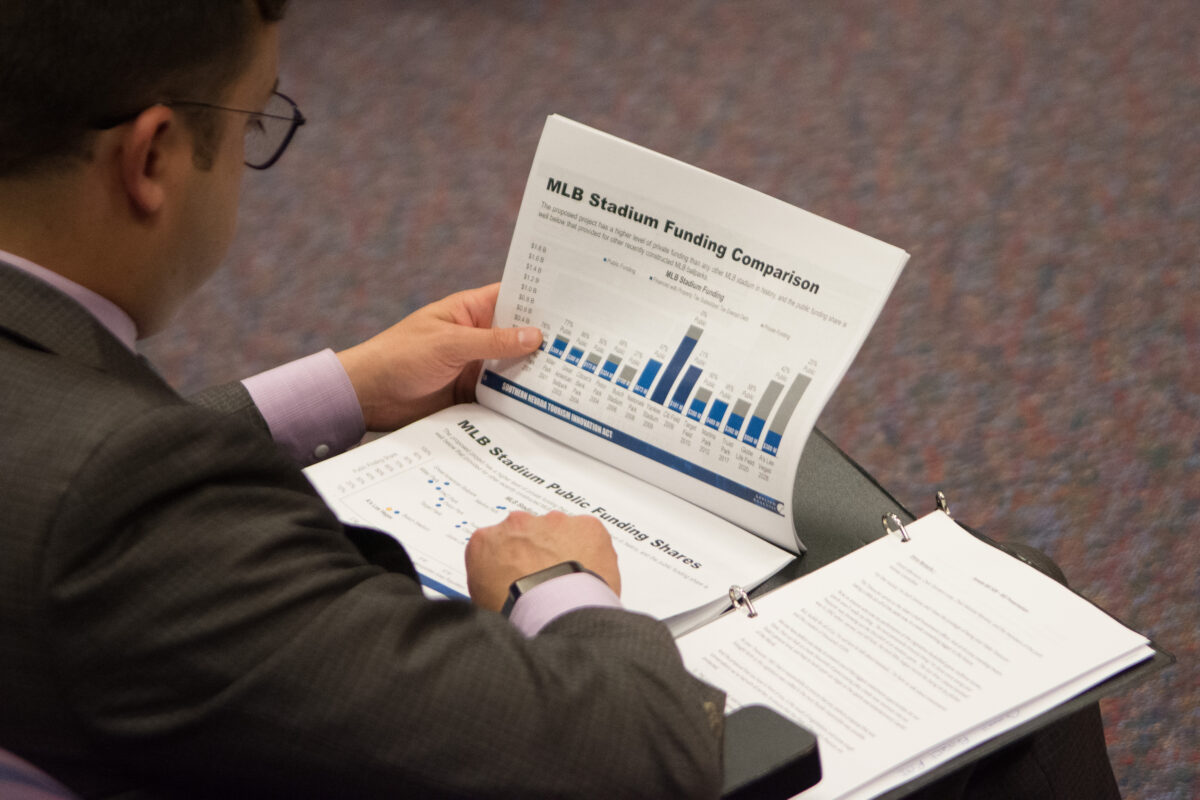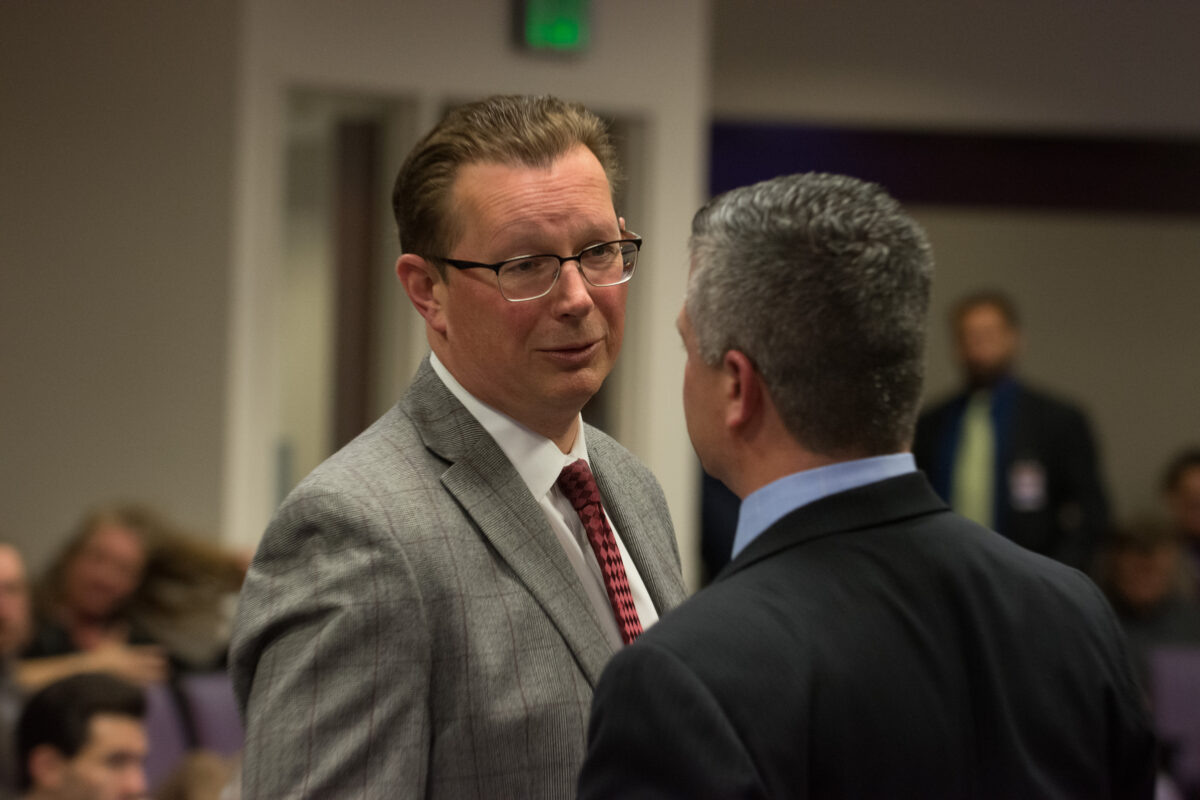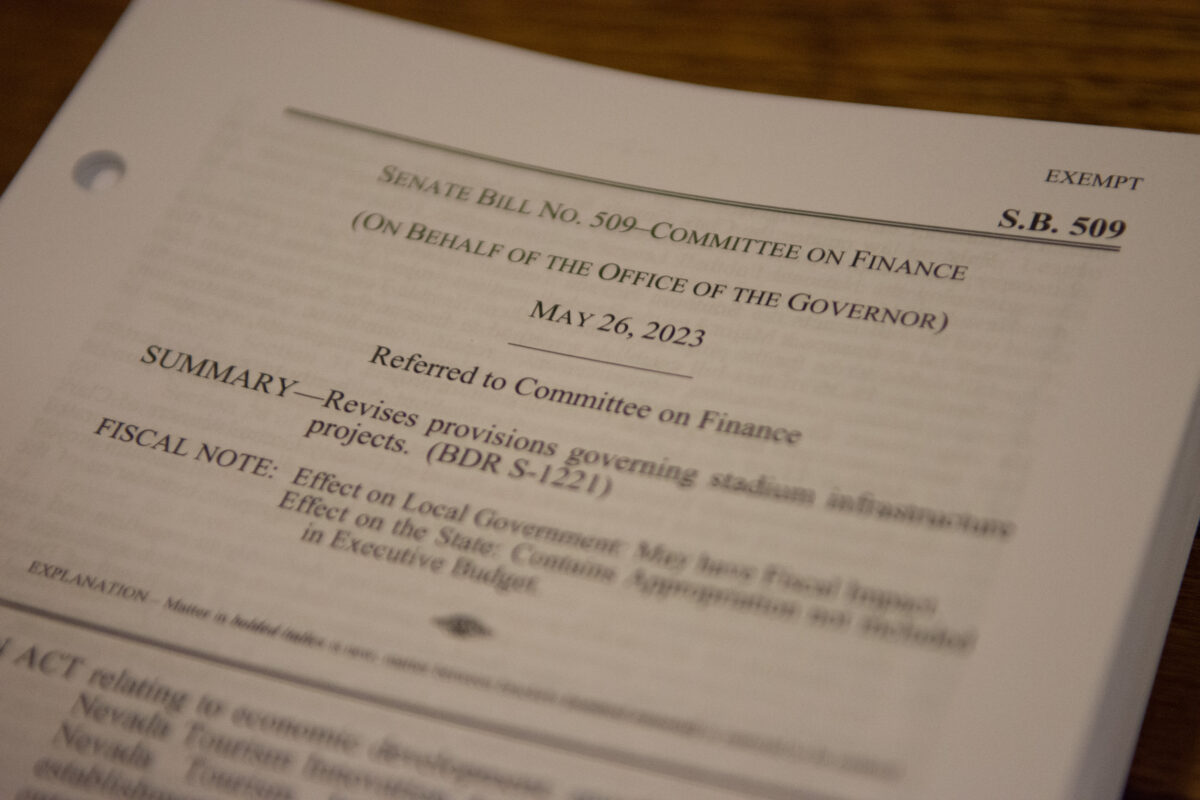A’s bill backers argue baseball’s worst team can be economic boon for Vegas

The Oakland A’s top brass were noticeably absent from the Legislature during the first, and likely only, hearing Monday of the nine-figure public financing measure to bring the team to Las Vegas.
During the more than five-hour hearing on SB509, backers of the deal focused on the nuts and bolts of the legislation, which proposes up to $380 million in public funding to help construct a $1.5 billion, 30,000-seat stadium for the team on the Las Vegas Strip. But those proponents faced pushback from lawmakers, who raised questions about the size and potential return on the investment of those public funds.
Read more about the details of the legislation here.
“Today was not the day for a dog and pony show,” said one A’s representative who asked not to be named. A’s President Dave Kaval and team owner John Fisher, are expected to be in Carson City later this week to meet with lawmakers.
The team brought three Nevadans to provide an in-depth financial presentation at the outset of a joint hearing by the Legislature’s two budget committees, Senate Finance and Assembly Ways and Means. The joint hearing expedites the legislative process and is fairly routine as lawmakers rush to complete business during the 120-day session’s final days.
Gov. Joe Lombardo’s Chief of Staff Ben Kieckhefer opened the hearing by saying Las Vegas hosts the NHL’s Vegas Golden Knights, the WNBA’s Las Vegas Aces and the NFL’s Las Vegas Raiders, and the addition of the A’s would help round out the destination as the sports capital of the country.
“We believe that adding Major League Baseball to Las Vegas Boulevard is the next logical step in that evolution,” Kieckhefer said.
He added the stadium construction offers the opportunity to create thousands of jobs and establish what he called a “publicly owned community asset that will continue to support the state's primary economic engine.”
“We also believe that this is a fiscally responsible financing package,” Kieckhefer said. “Critically, it contains no new taxes imposed against the residents of Nevada or our guests.”
Other presenters included Jeremy Aguero, an economist and founder of Las Vegas-based fiscal and data research firm Applied Analysis which is consulting the A’s, Treasurer Zach Conine and Steve Hill, CEO of the Las Vegas Convention and Visitors Authority and chairman of the Las Vegas Stadium Authority — a public body responsible for oversight of Allegiant Stadium that would also oversee the operations of the baseball stadium under SB509.


The presenters told lawmakers Monday the financial package had built-in guarantees that would protect the public investment, including reserves to backstop repayments of the public funds.
Conine said drawing the A’s to Las Vegas and providing $380 million toward the stadium costs represents “one of the biggest investment opportunities for our state.” He added that all tax revenues generated within the stadium’s 9-acre footprint — including sales, payroll and other taxes — would be used to pay the principal and interest for the bonds.
Conine said the county will invest $120 million in bonds supported by revenue from the stadium district. He estimated the taxes would be $38 million during construction because of the sales tax from materials. The figure would drop to $10 million once the stadium opens, growing to about $22 million a year over the term of the bonds
Aguero, whose firm has been involved in several other high-profile tax measures submitted to lawmakers, helped write the public funding legislation that led to the development of the $1.9 billion Allegiant Stadium, which — similar to the push behind SB509 — drew the Oakland Raiders to Las Vegas.
However, he told The Nevada Independent that though the agreements mirror the Raiders deal, the financing portion of the bill relies on bonding and transferable tax credits and is completely different from the room taxes that were used to create Allegiant Stadium.
Bill backers said developers are expected to begin constructing the stadium in 2024 or 2025 and complete the project in 2028 — just in time for Major League Baseball’s opening day and one year later than the team previously predicted. Aguero attributed the delay to the fact that construction can’t begin until the Rat Pack-era Tropicana is demolished.
He also defended a prediction that the baseball stadium would bring in 762,000 annual visitors, despite the team ranking dead last in Major League Baseball team attendance. He estimated baseball games and other stadium events could draw more than 2.6 million people annually — including an average of 28,000 attendees per baseball game, which would put the stadium’s average capacity rate at one of the highest levels of any Major League Baseball team.
Aguero said in an interview prior to the hearing that Applied Analysis used information based on the region, data gathered from stadiums and other arenas within the area to generate the analysis and estimates presented to lawmakers.
Those who testified in support of the bill Monday included representatives from organized labor, including Culinary Workers Local 226, which has an agreement to organize stadium employees after it opens, and the Southern Nevada Building Trades, which has a Project Labor Agreement with the A’s to build the stadium.
Vegas Chamber of Commerce CEO Mary Beth Sewald said the bill is the "next important step in investing in our future and will help solidify our role as a global sports destination and will definitely benefit the entire state."
Opponents of the legislation pushed back against the project, noting that the A’s have reneged on past deals and not contributed to the Oakland community in a meaningful way. Progressive advocates and community members emphasized that the funding for the A’s could be better used for other needs in the community, such as education, housing among other priorities.
“This has been like the Eras Tour of all of the worst ideas I've seen in this building,” said Battle Born Progress Executive Director Annette Magnus, referring to Taylor Swift’s ongoing concert series. “Stadiums are a bad deal.”
Assemblywoman Daniele Monroe-Moreno (D-North Las Vegas), who chairs the powerful Ways and Means Committee, said outright she would oppose the bill as-is. If the bill advances out of the Senate, it will have to pass through the committee she chairs before reaching the Assembly floor.
“I'm just going to put it out there — I'm at a no,” Monroe-Moreno said. “Almost a hell no. So y'all have to get me to a yes.”
Monroe-Moreno also cited the A’s fanbase hostility toward the owner of the A’s and asked presenters how the bill would ensure the team works to benefit the community.
“That will need to be built into the Community Benefits Agreements as we work through that process in public,” Hill responded.

Other components of the legislation
Though SB509 is broadly similar to the bill that helped land the Raiders in Las Vegas, including requirements for a community benefits agreement and provisions granting power to the Stadium Authority, it proposes a significantly different funding mechanism than the money behind Allegiant Stadium — which involved a record $750 million in public funds, an amount still being paid off through a Las Vegas hotel room tax.
The $380 million in public financing proposed for the A’s baseball stadium would come from a combination of transferable tax credits issued by the state and public bonds issued by Clark County. Those public funds would be paid off through tax revenues generated by the stadium via a “sports and entertainment improvement district” that the bill would require county commissioners to create.
Clark County Commission Chairman Jim Gibson, who testified in support of the bill, told lawmakers the county's commitment to the project is "fiscally sound" and that there are backstops in place to prevent burdens from falling on county residents.
As revenues are generated via the development and operation of the stadium — from the purchase of construction materials to ticket sales to payroll taxes for stadium staff — those funds would be directed through a waterfall of funding priorities over the span of 30 years. That includes paying off the county bonds and the operations of the stadium authority, filling up reserves meant to back up bond payments if revenue from the district comes up short and eventually supporting a homelessness prevention and assistance fund.
Through a combination of the bonds, tax revenues from the district and a credit line from the state, the bill would first direct a significant portion of funds to reserves and debt service coverage — protections meant to ensure the county would not have to draw on its general fund to support the bonds.
“Functionally, that means that we would need to be under revenue pretty significantly for more than four years in a row before the county [general fund] would be tapped into,” Conine said.
Aguero also noted the A’s would be responsible for any overrun costs for the project, leaving public funding capped at $380 million while the organization would foot the bill if the stadium cost ends up higher than the projected $1.5 billion.
During an interview Monday, Hill also addressed a clause within the proposed legislation that would exempt the stadium project from a law requiring competitive bidding, saying it was included because of “a timeframe concern” and that it “takes a good amount of time to go through a competitive bidding process.”
“There are very few contractors who can actually choose to build either a football stadium or baseball stadium,” he said.
Asked about a clause that would stipulate the confidentiality of certain financial information provided to the Stadium Authority, Hill said the language is copied from the 2016 Allegiant Stadium public funding bill.
Hill added that the confidentiality provision is designed to protect trade secrets and should not prevent the public from having access to information pertinent to finances around the stadium deal.

How we got here and what’s next
The legislation is the culmination of weeks of backroom discussions that followed in the wake of the April announcement that the A’s had finalized and decided to purchase a 49-acre site on Tropicana Boulevard and Dean Martin Drive from Red Rock Resorts. A week later, it was revealed that the A’s had abandoned the Red Rock site and moved a mile east on Tropicana Boulevard to 9 acres of a 35-acre site on the Strip that houses the Tropicana Hotel and Casino.
Aguero and Hill told lawmakers that the team and state leaders had agreed to the proposed $380 million public financing package a week ago.
But not all state legislators were a part of that agreement, with some lawmakers skeptical about the projections on attendance and revenues, and the need to direct public money toward the project at all.
Assemblywoman Michelle Gorelow (D-Las Vegas), who did not clarify how she would vote, said that she had received “a lot” of emails and social media pleas from constituents asking her and her colleagues to vote no. Assemblywoman Selena La Rue Hatch (D-Reno), tweeted during the meeting that the New York Yankees built their stadium without direct public funding (but did receive about $1.2 billion in public funds, mostly bonds, to build their stadium).
“Clearly this can be done with private capital, especially for the smallest stadium in the nation,” she wrote.
Assemblyman Howard Watts (D-Las Vegas) compared the Tropicana, which would be demolished to make room for the stadium, to the A’s performance on the field. At 10-45 (a 0.182 win percentage) so far this season, the A’s are not only the worst team in Major League Baseball but the worst team by win-loss record in major league history at this point in the season.
“The Tropicana is the A’s of the Strip,” Watts said.
Assembly Speaker Steve Yeager (D-Las Vegas) — who did not specify how he would vote on the bill, but whose office was instrumental in negotiating the deal — also echoed concerns over a potential fan base and pressed proponents on how attendance projections could be so high when the A’s have historically (and recently) underperformed on the field.
Aguero called the A’s current attendance "abysmal" but said they could improve attendance numbers by moving to Las Vegas, though he added — without speaking for the A’s — that the team would have to “put an outstanding product” on the field. The A’s also field the team with the lowest payroll in the major leagues.
Even outside the baseball and economic questions, key logistics questions went unanswered. Sen. Robin Titus (R-Wellington) questioned the stadium’s location, tucked near one of the north/south runways at Harry Reid International Airport.
“I'm a pilot and wondering about how location relative to the airport will affect the proposal,” she asked.
“There are a number of issues that can be mitigated and will need to be mitigated,” Hill said, adding that fireworks would be prohibited and a scoreboard would have to be positioned to not create issues for pilots.
Titus also asked about how much money the bill would generate for a fund aimed at those experiencing homelessness.
Aguero said he was not totally sure about the answer to that question, but the project will have to “overperform” for the Stadium Authority to deposit money into the fund.
If lawmakers and the governor approve SB509, the A’s will have 12-18 months to enter into multiple agreements, including a development agreement and a lease agreement, with the Stadium Authority before moving forward with the stadium project.
Hill said the Tropicana would be demolished regardless of the outcome of the bill. But because of that demolition, any construction timeline would stretch over five full years.
Another factor in the move is a relocation decision by Major League Baseball. MLB Commissioner Rob Manfred said a vote on the A’s relocation to Las Vegas could come when league owners meet from June 13-15 in New York, the Associated Press reported. Though the A’s are likely to have their relocation fee waived, Aguero said such a fee could run as much as $300 million.
Asked by lawmakers what the A’s would do if the stadium deal falls through in Nevada, Hill responded that if the deal falls through, the team “will look for other cities.”



